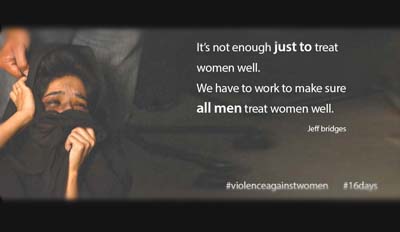Asian Indicators of GBV
By Umema Babar
The 21st century is notable for the marked rise in global economy, the digital revolution, scientific and innumerable technological developments. It has changed our outlook so much so that we have started claiming to be more economically and socially stable. But does our supposed statistical graph of growth say that?
Global experiences have repeatedly demonstrated that gender-based violence is pervasive across class, religion, ethnicity and the urban/ rural divide. its roots in a patriarchal social structure in which women are subservient to men, and are viewed as property.
According to the Human Rights Watch, gender-based violence occurs as a cause and consequence of gender inequities. It includes a range of violent acts mainly committed by men against women. Power is what dictates the position of women and girls at the household, community and policy levels.
Asia is the world’s largest continent and so is the most populated mainland with 4.4 billion people. Apart from such geographical indicators, Asia is also dominant for its economic importance as it contributes 40 percent to the global GDP. But unfortunately for the land of 60% of world population, gender equality is still a long-awaited goal to achieve. In many Asian countries, women have very restricted social and economic roles. Here women face gender discrimination while exerting their legal rights, like in Russia, the government denies the women’s right to equal protection.

In India, 70% of women are victims of domestic violence. The crimes against women here are committed after every 3 minutes. According to a survey, 65% of men in India believe that women deserve to be beaten up and in order to keep a family together they should tolerate this violence. The cases of dowry deaths are accounted 27.3% in UP and 15.5% in Bihar nationwide. Not only this, woman in India are also being emotionally violated, resulting 7.5% attempting suicides.
More than 5000 cases of violence against women were recorded in six months in Afghanistan. The afghan women after the Taliban war are still being stoned to deaths. The women fleeing from their husbands get longer punishments than those who committed murders. The famous ‘Love Crimes of Kabul’ is a documentary that highlights these social drawbacks in Afghanistan heartbreakingly.
According to All-China Women’s Federation about a quarter of all married women in China have suffered violence. Around 90% of reported cases include abuse against women. After the long campaign of civil society groups, China passed its first ever law against domestic violence which will hopefully help removing many barriers in the path to justice. Although admittedly effectively implementing this law is now their biggest challenge.
Coincidentally, according to majority of the victims of domestic violence, the law enforcement officials usually refuse to take appropriate action against perpetrators, labelling it a family matter; thanks to the conservatively rigid social set-up of societies that continues to find covert and overt means to legitimize such behavior. Such denial stimulates discrimination against women and keeps gender equality an elusive dream.
In Pakistan the upsurge in incidences of rape, domestic violence, dowry deaths and harassment are a serious cause of concern. The Islamic Republic of Pakistan is the sixth most populous country in the world, and is ranked 125th out of the 169 countries on the Gender Development Index (GDI), and 99th out of 109 on the Gender Empowerment Measure .
Owing to the vibrant global woman's movement and a vigilant media, concern and outrage over the pervasiveness, magnitude and influence of gender-based violence has grown over the last decade. There is now widespread recognition that this is a global human rights problem requiring a comprehensive and coordinated response from civil society, the state and the international community. But violence against women is a pandemic affecting many countries, even those that have made laudable progress in other areas; be it the sophisticated West or the under-developed and developing areas of the East.
The only way to leash this monstrosity is by working together as a society against gender biases, ensuring justice to the wronged and enforcing gender equity via social, legal, political and economic practices.








